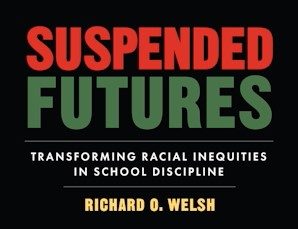By Jenna Somers

Racial inequality in school discipline is a major problem across the United States. Black students experience disproportional office disciplinary referrals and out-of-school suspensions, which lead to greater losses in instructional time. Reducing the use of exclusionary discipline is critical for improving academic achievement and educational equity from preschool through twelfth grade. Researchers suggest that policies to reduce racial inequality in exclusionary discipline should focus on investments to improve school climate; diversify teachers and administrators and retain experienced ones; and provide professional development training on discipline, relationship building, classroom management, and cultural competency, especially for less experienced teachers.
That’s according to Richard Welsh, associate professor of education and public policy at Vanderbilt’s Peabody College of education and human development and founding director of the School Discipline Lab. Welsh recently published a study in School Effectiveness and School Improvement that demonstrates pivotal school-level differences between inclusive disciplinary schools—those that have “beaten the school discipline odds”—and median and high disciplinary schools, both of which have higher disciplinary rates for Black students.
Welsh conducted this empirical case study of New York City schools in collaboration with Luis Rodriguez and Blaise Joseph, researchers at New York University. They categorized schools into four groups: all schools, predominantly Black schools, predominantly Latinx schools, and schools where most students are eligible for free and reduced priced lunch (FRPL). Within and across each group, they identify and describe inclusive, high, and median disciplinary schools, finding key differences at the school level that may contribute to low rates of and disparities in suspensions for Black students at inclusive disciplinary schools in comparison to other schools.
“Given that school discipline conversations are sometimes riddled with deficit perspectives regarding Black students and families, applying an asset-based approach that highlights schools’ agency is an important and necessary direction for research on discipline disparities. This study attempts to move the field forward by identifying and learning from schools doing school discipline right,” Welsh said.
Among all schools, there are stark contrasts between high disciplinary and inclusive disciplinary schools along race and class lines. High disciplinary schools have larger proportions of both Black and low-income students. In particular, the proportion of FRPL-eligible students is much higher at high disciplinary than inclusive disciplinary schools. Inclusive disciplinary schools tend to have larger proportions of Asian, White, and other-race students than median and high disciplinary schools. Notably, inclusive disciplinary schools serve larger proportions of students living outside the schools’ neighborhoods, suggesting they are in-demand schools that attract more White and affluent students.
Positive school climate and teacher and administrator experience also distinguish inclusive disciplinary schools. Teachers and students at inclusive disciplinary schools report much more positive feelings toward their school. Teachers and administrators at these schools have significantly more experience in their roles, indicating that lower rates of and disparities in exclusionary discipline may be supported by more experience in the classroom and in school leadership.
The diversity of teachers and school leaders may also play a significant role in disciplinary outcomes, especially for students of color and those from low-socioeconomic backgrounds. Among all schools, inclusive disciplinary schools have fewer Black and Latinx teachers, but predominantly Black inclusive disciplinary schools have greater teacher racial diversity and are much more likely to have Black or Latinx assistant principals. Additionally, majority Latinx and FRPL inclusive disciplinary schools are more likely to have Black or Latinx principals. This information suggests that racial diversity of teachers and leaders is correlated with positive disciplinary outcomes for Black, Latinx, and low-income students.
Neighborhood characteristics play a role in identifying inclusive, median, and high disciplinary schools, but they are significantly less important for identifying whether predominantly Black schools are inclusive, median or high disciplinary. This finding reinforces the idea that a focus on school-level factors may be more important for reducing racial discipline disparities. Furthermore, majority-Black inclusive disciplinary schools may serve as the best models for improving disciplinary outcomes.
The latest findings and new directions of Professor Welsh’s research can be found at the School Discipline Lab. Register for updates.

